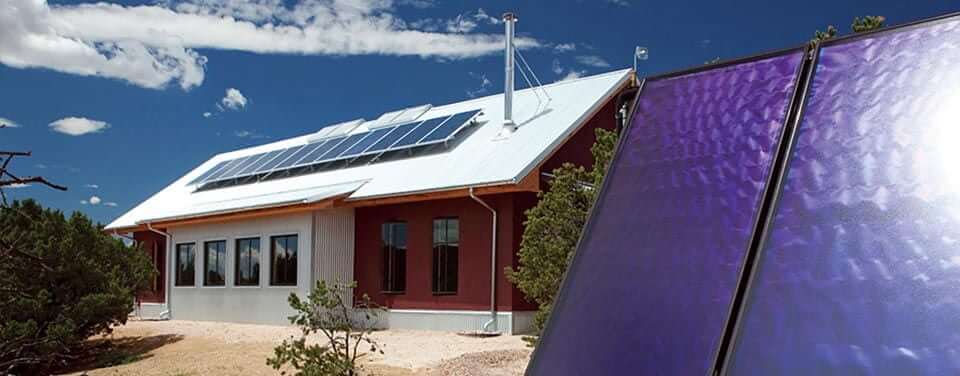
Passive Solar Design: Making the Most of Nature’s Energy
Passive solar design is foundational to the way we approach home building. In a city like Santa Fe, passive solar design can have a massive impact on the efficiency and sustainability of your home.
How does Palo Santo Designs incorporate passive solar design into its homes? Keep reading to find out more about how we work.
What is Passive Solar Design?
Passive solar design involves creating homes and home features that take advantage of the sun’s energy. This involves understanding the orientation, layout of window glazing and use of overhangs to maximize the heating potential of the sun’s warming rays in the home during winter, while simultaneously maximizing shading of those same rays during the summer months to avoid unwanted heating. Once the basic accounting of the solar angles of the sun in winter vs. summer and the correct sizing and shading of window glass is harnessed, then the importance of creating a super insulated building envelope which includes thermal mass elements within the home yields paybacks
The result: Homes build according to basic passive solar design principles will have minimal heating and cooling costs as compared to homes which are designed without any thought as to solar heat gain. And, properly designed and build passive solar homes will also maximize the comfort of those dwelling in the home, because the temperature extremes of heat and cold outside the home are insulated away from the interior, reducing temperature fluctuations.
Passive solar design allows you to reduce heating and cooling loads in the most cost-effective way, because passive solar design typically adds little or nothing to the cost of constructing a home.
Key Features in Passive Solar Design
When building homes with energy efficiency in mind, you need to take a few things into account, including all of the following:
-Site Selection: New passive solar home construction projects will require a portion of the south side of the house to have an unobstructed view of the sun. This can be harder than you think: mature trees and other buildings nearby could block your south-facing exposure, which could compromise the efficiency of your passive solar home. Great passive solar design starts with intelligent site selection.
-High-Performance Building Envelope: The thermal envelope can also be thought of as the “shell: of the home. The materials and methods which go into creating the exterior walls, roof and opening in the outside of the building. At Palo Santo Designs we have learned through 15 years of experience that the most cost effective way to achieve a high-performance building envelope in Northern New Mexico’s climate is with the use of 2×6 or 2×8 stud wall construction, with 2”-3” of insulating foam placed around, under and over the entire building. All wall and ceiling cavities are then packed with blown-in insulation. Additionally, we air seal all exterior surfaces and penetrations to assure that drafts are minimized. And finally, we use only ENERGY STAR rated windows and doors. These features, when properly combined and installed will create a super energy efficient and high performing building envelope which serves as the foundation for comfort, energy efficiency and very effective passive solar design, without busting the budget.
-Properly-Designed Windows: Windows and glass doors should be designed in such a way as to not over expose the home to solar gain. A qualified passive solar designer will be able to make the window sizing calculations that best suit the size and layout of your new passive solar home. Additionally, exposed south facing glass needs to be provided with shading during the summer months. Roof overhangs and other architectural projections can be designed with the summer sun angle of the house location in mind to maximize solar gain in winter and minimize solar gain in summer. In the early days of passive solar design, many examples tended toward over doing the size of glass facing south, and little attention was paid to the importance of overhangs, leading to an overheating situation, especially in the summer months. This is not good passive solar design.
-Thermal Mass: One of the key parts of passive solar design involves taking thermal mass into account – like concrete, brick, stone, and tile; heavy building materials that easily absorb and re-radiate heat. These thermal mass components act as heat sinks in the winter months storing the solar gain radiated into the home and also as a “cool” sinks in the summer months when little or no solar gain enters the home. During the summer shading conditions provided by properly designed windows and overhangs, thermal mass will absorb latent heat from the air, thus keeping the ambient air temperature cool relative to a space without thermal mass, reducing the need for mechanical cooling. When designing a home, one of the key goals is ensuring that thermal mass materials are sufficiently sized to have an appreciable impact on the ambient temperature. Although it is not absolutely necessary to moderate temperatures, thermal mass with an unobstructed view of sunlight is the most effective.
Passive Solar Design in Santa Fe Available Through Palo Santo Designs
Homes with passive solar design are vastly more efficient. It minimizes your environmental impact – and your utility bills. Talk to Palo Santo Designs today and start planning your dream home with passive solar design systems.



